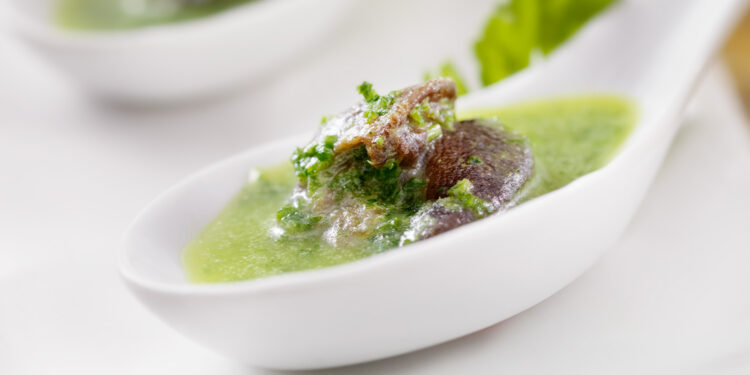To Sauce, or Not to Sauce? – Part 1: Choosing the Right Sauce for Your In-Flight Catering

This is a post by author David Burger. David is the general manager and executive chef for the Air Culinaire Worldwide headquartered kitchen in Ashburn, Virginia. Air Culinaire Worldwide is headquartered in Tampa and has kitchens in Aspen; Boston; Chicago; Dallas; Denver; Las Vegas; London; Long Beach; New York; Paris; San Francisco; Seattle; Van Nuys; West Palm Beach; and Washington, D.C. In addition, Air Culinaire Worldwide provides in-flight catering services at airports around the world via hundreds of catering partners. David is an expert in catering for business aviation and can be contacted at davidburger@airculinaire.com.
This business aviation blog post is part one of a two-part series on sauces for in-flight catering.
Sauces can add to, or detract from, in-flight entrees or side dishes aloft. There’s an art to ordering, re-heating, and serving sauces. If chosen and prepared well, the right sauce at altitude can make an in-flight meal more successful and the overall flight experience even more enjoyable for passengers.
If you want to add sauces to your in-flight catering, here’s what you need to know about preparing sauces:
1. Sauces are essential elements of in-flight catering
Some sort of sauce is usually included for pretty much every entree served in-flight. In some cases, sauces will be selected due to passenger preference, and, in other cases, sauces may be chosen by a flight attendant or recommended by a chef. Chefs often try to pair sauces with particular entrees and side dishes.
2. A wide range of sauces is available
While there are hundreds of potential sauces and variants to consider, five sauces in general form the basis for any sauce you wish to create:
- For example, Bechamel sauce is a dairy product thickened with “roux” (fat and flour), and it forms the basis for any type of cream sauce. Cheese sauces usually start with a bechamel.
- The second sauce category is Espanola. This is a dark brown sauce thickened with roux and a dark stock, such as that of beef or veal. If you add mushrooms and shallots, for example, to an Espanola sauce, it becomes a “Hunter’s sauce.”
- Veloute is the third category of sauce. It’s similar to an Espanola, but a light stock – such as fish or chicken – is added to the roux, and it may also include cream and herbs.
- The fourth sauce category is Hollandaise. This is a butter- and egg yolk-based sauce used most commonly with Eggs Benedict. There are many variations to Hollandaise-type sauces. Bearnaise sauce is a variation of Hollandaise which uses butter and wine, but no egg yolk, and is the basis for a beurre blanc sauce.
- The fifth sauce category includes tomato sauce. This is a sauce typically created with fresh tomatoes or puree and thickened with roux. There are many variations of tomato sauce, and it is most frequently used with pasta.
3. Sauces can bring a meal to life
Sauces add another level of flavor to enhance, or complement, both main and side dishes. They can also add or change the texture of a dish. Be aware, however, that a sauce can take away from a meal if it goes against the seasoning of the entree or is not prepared properly. Your chef, or in-flight caterer, will make recommendations as to which sauce goes with which entree.
4. With the right sauce, entrees will be more compelling
Sauces can add moisture to an entree and make them more palatable. Some sauces – such as Espanola and tomato sauces – can be used effectively to heat an entree by just heating the sauce and not the whole dish. Bechamel and Hollandaise sauces, however, are not practical for the purposes of heating entrees. In most cases (the exception may be pasta dishes), it is best to keep sauces on the side. Certain textured entrees – such as breaded chicken – should never be exposed to sauces for too long prior to consumption.
5. Best techniques for heating a sauce
When heating sauces, the “slow and low” theory works best. This is especially important for Hollandaise and Bechamel sauces so they do not “break.” (When butter separates in the sauce, it’s referred to as “broken,” and it can be difficult to blend the butter into the sauce again.) How you heat a sauce will depend on your onboard heating mechanisms. Keep in mind that when heating sauces, it’s important to stir often.
Conclusion
When selecting sauces, for either entrees or side dishes, trust the expert advice of your chef, in-flight caterer, or flight attendant. Assuming the passenger does not have a specific sauce request, you’ll need to pair the sauce and entrees correctly for the most successful result.
Questions?
If you have any questions about this article or need help arranging your next in-flight catering order, contact me at davidburger@airculinaire.com.
Stay tuned for Part 2, which covers more information on sauces.




